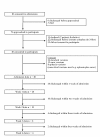Developing and evaluating the implementation of a complex intervention: using mixed methods to inform the design of a randomised controlled trial of an oral healthcare intervention after stroke
- PMID: 21729277
- PMCID: PMC3155479
- DOI: 10.1186/1745-6215-12-168
Developing and evaluating the implementation of a complex intervention: using mixed methods to inform the design of a randomised controlled trial of an oral healthcare intervention after stroke
Abstract
Background: Many interventions delivered within the stroke rehabilitation setting could be considered complex, though some are more complex than others. The degree of complexity might be based on the number of and interactions between levels, components and actions targeted within the intervention. The number of (and variation within) participant groups and the contexts in which it is delivered might also reflect the extent of complexity. Similarly, designing the evaluation of a complex intervention can be challenging. Considerations include the necessity for intervention standardisation, the multiplicity of outcome measures employed to capture the impact of a multifaceted intervention and the delivery of the intervention across different clinical settings operating within varying healthcare contexts. Our aim was to develop and evaluate the implementation of a complex, multidimensional oral health care (OHC) intervention for people in stroke rehabilitation settings which would inform the development of a randomised controlled trial.
Methods: After reviewing the evidence for the provision of OHC following stroke, multi-disciplinary experts informed the development of our intervention. Using both quantitative and qualitative methods we evaluated the implementation of the complex OHC intervention across patients, staff and service levels of care. We also adopted a pragmatic approach to patient recruitment, the completion of assessment tools and delivery of OHC, alongside an attention to the context in which it was delivered.
Results: We demonstrated the feasibility of implementing a complex OHC intervention across three levels of care. The complementary nature of the mixed methods approach to data gathering provided a complete picture of the implementation of the intervention and a detailed understanding of the variations within and interactions between the components of the intervention. Information on the feasibility of the outcome measures used to capture impact across a range of components was also collected, though some process orientated uncertainties including eligibility and recruitment rates remain to be further explored within a Phase II exploratory trial.
Conclusions: Complex interventions can be captured and described in a manner which facilitates evaluation in the form of exploratory and subsequently definitive clinical trials. If effective, the evidence captured relating to the intervention context will facilitate translation into clinical practice.
Figures
References
-
- Nuttall NM, Bradnock G, White D, Morris J, Nunn J. Adult dental health survey: Dental attendance in 1998 and implications for the future. Brit Dent J. 2001;190:177–182. - PubMed
-
- Pedersen AM, Bardow A, Beier Jensen A, Nauntofte B. Saliva and gastrointestinal functions of taste, mastication, swallowing and digestion. Oral Dis. pp. 117–129. - PubMed
Publication types
MeSH terms
Grants and funding
LinkOut - more resources
Full Text Sources
Medical



